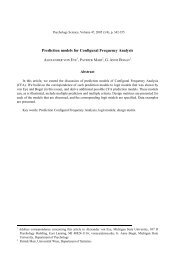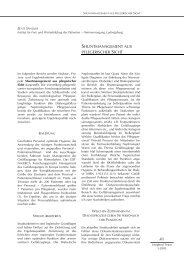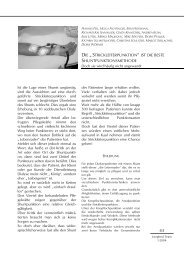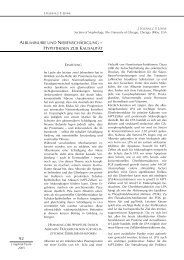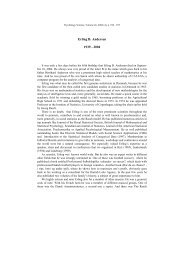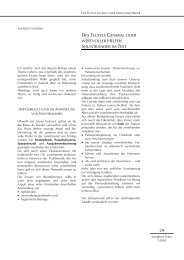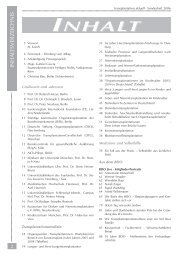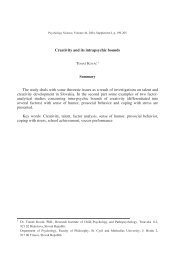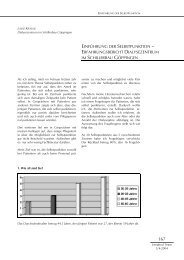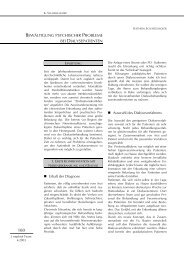Identifying rater effects using latent trait models Abstract
Identifying rater effects using latent trait models Abstract
Identifying rater effects using latent trait models Abstract
Create successful ePaper yourself
Turn your PDF publications into a flip-book with our unique Google optimized e-Paper software.
Rater <strong>effects</strong> 37<br />
Another line of research has focused on characteristics of <strong>rater</strong>s, the rating task, and the<br />
rating environment that relate to the presence of <strong>rater</strong> <strong>effects</strong> in ratings (Dean, 1980; Hoyt,<br />
1999; Hoyt, 2000; Jako & Murphy, 1990; McIntyre, Smith, & Hassett, 1984; Murphy &<br />
Anhalt, 1992; Tziner & Murphy, 1999; Welch & Swift, 1992; Yu & Murphy, 1993). Some of<br />
these studies have suggested that the manner in which information is presented to <strong>rater</strong>s and<br />
the way that <strong>rater</strong>s process that information may introduce certain types of <strong>rater</strong> <strong>effects</strong>, such<br />
as proximity errors or halo <strong>effects</strong>. Others have suggested that certain types of errors have a<br />
more severe impact on the reliability and validity of ratings.<br />
The third line of research has focused on the impact of <strong>rater</strong> <strong>effects</strong> on ratings and developing<br />
methods for statistically modeling and correcting for <strong>rater</strong> <strong>effects</strong> (Braun, 1988; de<br />
Gruijter, 1984; Engelhard, 1992, 1994, 1996; Houston, Raymond, & Svec, 1991; Longford,<br />
1996; Lunz, Wright, & Linacre, 1990; Murphy & Balzer, 1989; Raymond & Viswesvaran,<br />
1993; Vance, Winne, & Wright, 1983; Wolfe, Chiu, & Myford, 2000). Several of these authors<br />
have relied on analyses of raw scores and applications of generalizability theory. More<br />
recent efforts have focused on the development and utilization of <strong>latent</strong> <strong>trait</strong> applications.<br />
The study presented here is consistent with these more recent efforts. Prior to presenting<br />
those <strong>latent</strong> <strong>trait</strong> procedures, however, several types of <strong>rater</strong> <strong>effects</strong> that may be detected<br />
<strong>using</strong> these methods will be presented.<br />
Accuracy/Inaccuracy<br />
One of the most common concerns of those who utilize ratings to make decisions is<br />
whether <strong>rater</strong>s have been sufficiently trained or have sufficient expertise to assign accurate,<br />
rather than inaccurate, ratings. The ability to assign accurate ratings (i.e., the demonstration<br />
of <strong>rater</strong> accuracy) may be the result of experiences that the <strong>rater</strong> has had (e.g., training, education,<br />
work experiences), cognitive factors (e.g., thinking styles, learning abilities), and<br />
characteristics of the rating criteria (e.g., degree of similarity of the criteria and the <strong>rater</strong>’s<br />
beliefs and understanding of the domain in question) and the rating environment (e.g., freedom<br />
from distractions, types of social interactions that occur in that setting). Hence, the most<br />
suitable <strong>rater</strong>s maybe those who have thinking styles and belief systems that are consistent<br />
with the training approach and rating criteria. In addition, <strong>rater</strong> training, <strong>rater</strong> monitoring, and<br />
the structure of the rating task may facilitate accuracy by providing a suitable rating environment.<br />
Inaccuracy, the converse of accuracy, is a <strong>rater</strong> effect that is typically avoided by<br />
those who supervise the assignment of ratings.<br />
Rater accuracy and inaccuracy can be defined statistically by considering the impact that<br />
each of these <strong>effects</strong> has on the residuals of the observed scores from their expectations. The<br />
expected rating is the value of the expectation of assigned ratings across an innumerably<br />
large number of contexts (<strong>rater</strong>s, time, items, etc.). This expectation is sometimes referred to<br />
as the “true” rating (in true score test theory) or as the expected score derived from the rated<br />
individual’s parameter-based ability (in <strong>latent</strong> <strong>trait</strong> test theory). While <strong>rater</strong> accuracy results<br />
in a high degree of consistency between assigned ratings and expected, or known-to-be-valid,<br />
ratings 1 , <strong>rater</strong> inaccuracy results in low levels of consistency between assigned ratings and<br />
expected ratings. In this sense, accuracy manifests itself as small, randomly distributed patterns<br />
of residuals, where the residual is defined as the difference between the observed rating<br />
(X) and its expectation [E(X)], residual = X - E(X). That is, <strong>rater</strong> accuracy should result in a



